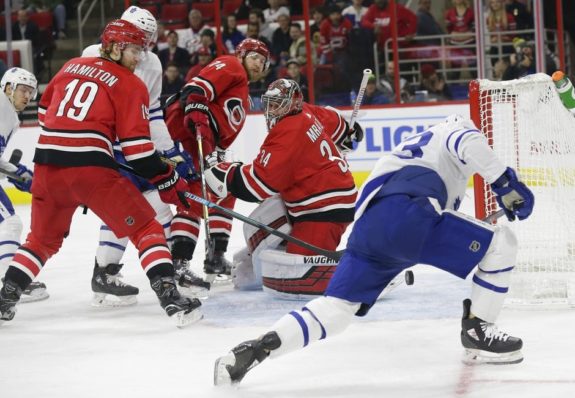In this edition of Toronto Maple Leafs News & Rumors, I’ll take some space to consider the kind of players the team will go after at the trade deadline. Second, I’ll look at Joseph Woll’s rise to the NHL roster and suggest that fans will see him get a start over the next couple of days.
Finally, I’ll look at some of the accusations of readers who comment about how the organization’s desire to make money has cannibalized its ability to ice a solid team. Included in the finger-pointing is — of course — general manager Kyle Dubas (who I wrote about a few days ago). However, Brendan Shanahan is also named as a culprit in the dysfunction of the organization.
Related: Maple Leafs Future Will Determine Dubas’ Deadline Deals
I know I’m going against the common beliefs of fans, and the last thing I intend to be is an apologist for the Maple Leafs organization. However, much of what I’m seeing fans write and say simply isn’t accurate. Yes, the Maple Leafs are not winning in the postseason. And yes, there are a variety of opinions about why that’s the case. But from what I’m seeing, the chase for money is not trumping the organization’s desire to build the best team possible.
Item One: What Kind of Player Will the Maple Leafs Seek at the Deadline?
To build their current team, the Maple Leafs have emphasized skill and speed in their roster construction. However, playoff hockey can be a different beast, where physicality and nastiness are valuable assets.
There’s no denying that having size and muscle on the team can help win puck battles and create more space on the ice. That said, it’s also important to have players who can “think the game” at a high level and make quick, smart decisions with the puck. That’s why Auston Matthews is such a great player: he and Leon Draisaitl are two players who quickly come to mind as players who exemplify the entire package rolled into one player.

It’s possible the Maple Leafs could benefit from adding a player or two who fits the big and nasty description, but it’s also worth considering the trade-off that comes with such additions. Players who bring size and physicality to the ice often sacrifice speed and skill, so finding the right balance is key.
Ultimately, the formula for playoff success is complex; and because different kinds of teams win the Stanley Cup season after season, there seems to be no one right answer. In fact, looking at what teams win the Stanley Cup seems to suggest a lot of “right answers” as to how to build a successful postseason winner.
Related: 4 Reasons Why This Could Be the Maple Leafs’ Stanley Cup Season
A deep playoff run requires a combination of skill, speed, size, physicality, goaltending, special teams, a host of other factors, and good luck. I am confident that, unless an explosive trade is on the horizon, the Maple Leafs will continue to tweak and adjust their roster in an effort to build the best possible team for playoff success.
Item Two: Brendan Shanahan’s Success as Maple Leafs President
As Andrew noted in the discussion section of a post this week, when Brendan Shanahan took the job as the Maple Leafs President, he declared that “the problem in Toronto is not coming up with the plan, it’s sticking with the plan.” (from “Leafs president Shanahan promises to stick to plan, for as long as it takes,” Kevin McGran, The Toronto Star, 13/04/2015).
To flesh that comment out further, Shanahan noted that “there are no shortcuts. Shortcuts have gotten this organization into trouble in the past.” Andrew went on to suggest that Brian Burke talked about building and developing players then promptly traded draft picks who could have turned the tide for the franchise.
From what I’ve seen in the time I’ve covered the Maple Leafs, Shanahan has been instrumental in turning around the franchise. He entered the job with a philosophy about how hockey should be played and a long-term vision to build a strong organization from the ground up. He’s stuck to it, and his efforts seem to be paying off.
The team has been successful in developing young talent through its minor-league affiliate teams. That talent is now starting to filter into and make an impact at the NHL level.
Related: The Ice Rink: A Brief History
Say what you want about the ownership group’s desire to make money, but it also seems committed to winning. The franchise spends considerable money on staffing throughout the organization. Furthermore, players who come to the Maple Leafs even for a short time have lauded the organization’s infrastructure.
As one specific example, one of my favorite players, Tyler Ennis, was with the team for only the 2018-19 season. But he spoke glowingly about how the team’s medical and training staff worked to help him recover from an injury. The scouting and coaching staffs are solid.

In short, from what I’m seeing, the organization’s commitment to winning can be seen by its willingness to spend on staffing and resources within the organization. There is an investment in minor league teams, scouting, and player development. Say it’s someone else’s doing, but it strikes me that Shanahan is the brains and engine behind these changes.
The Maple Leafs are building a foundation for sustainable success. Shanahan has focused on changing the culture of the organization. He made it a priority to strengthen the team’s connection to the past – much like former general manager Cliff Fletcher did following the death of problematic owner Harold Ballard.
Shanahan has helped heal some of the historical wounds with former players (Dave Keon, for example) and has worked to build a Maple Leafs alumnus. He’s helped make the Maple Leafs a destination where (a) players want to sign for “show me” seasons or (b) and where there’s a chance to win a Stanley Cup. Despite tax disadvantages, current players want to come to Toronto to play. That says loads to me.
Related: Darryl Sittler’s Magical 10-Point Game
The team has developed a strong pipeline of talent and now supplements its roster with players from within the organization. That pipeline improves the team’s depth (cheaply) but also helps maintain a consistent and cohesive team identity and philosophy.
Overall, the efforts of Shanahan and the Maple Leafs’ ownership group to build a strong and sustainable organization are paying off. I am likely in the minority, but I’m excited to see what the future holds for the team.
What’s Next for the Maple Leafs?
Speaking of Maple Leafs’ prospects moving through the system, it will be good to see Pontus Holmberg again. He has been brought back up to the NHL roster and will likely play tonight.

As a rookie with the Maple Leafs, he’s collected 13 points in 33 games. When Maple Leafs head coach Sheldon Keefe was looking for a “natural” center to play in the third-line spot early in the season, he decided to call up Holmberg. It has proved to be a good decision.
